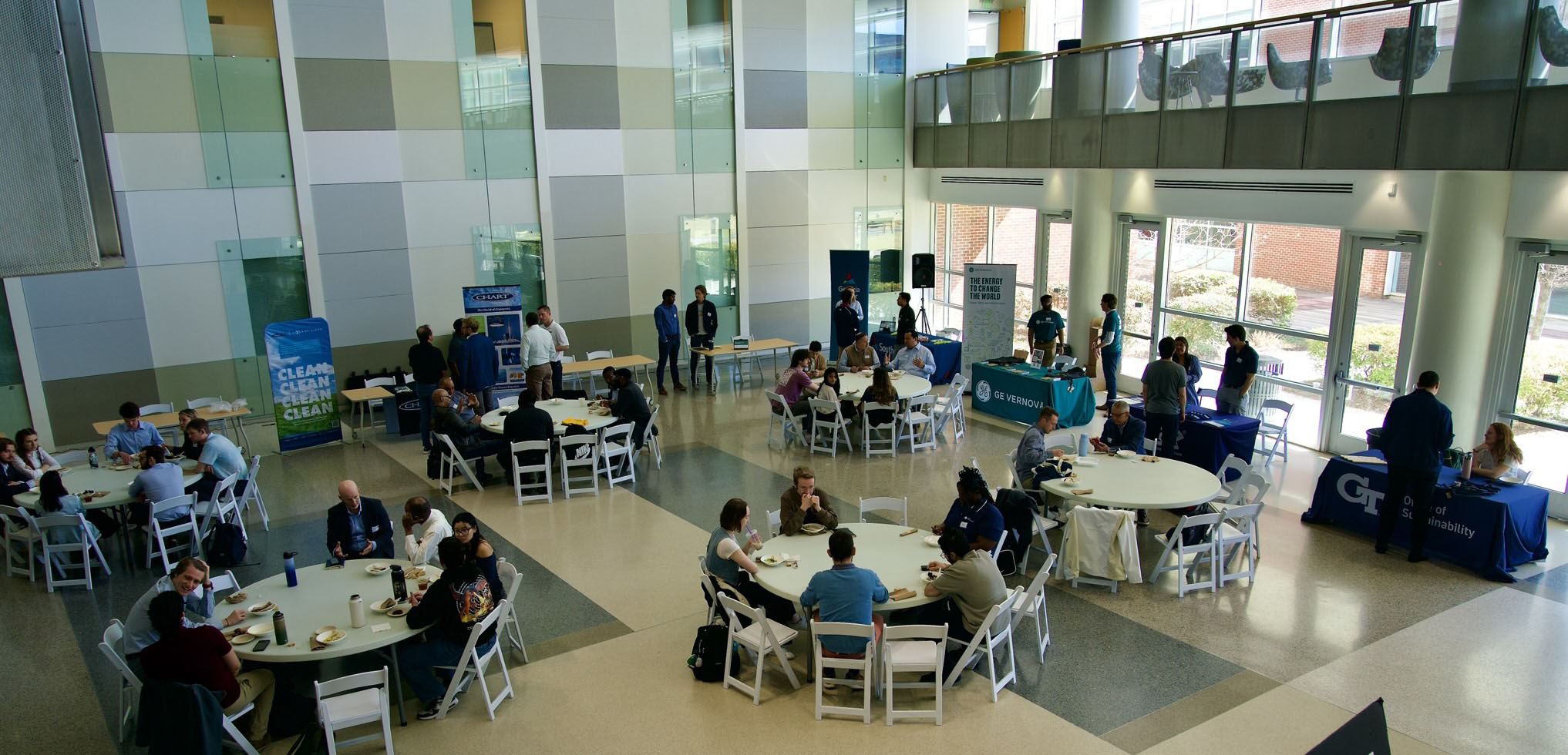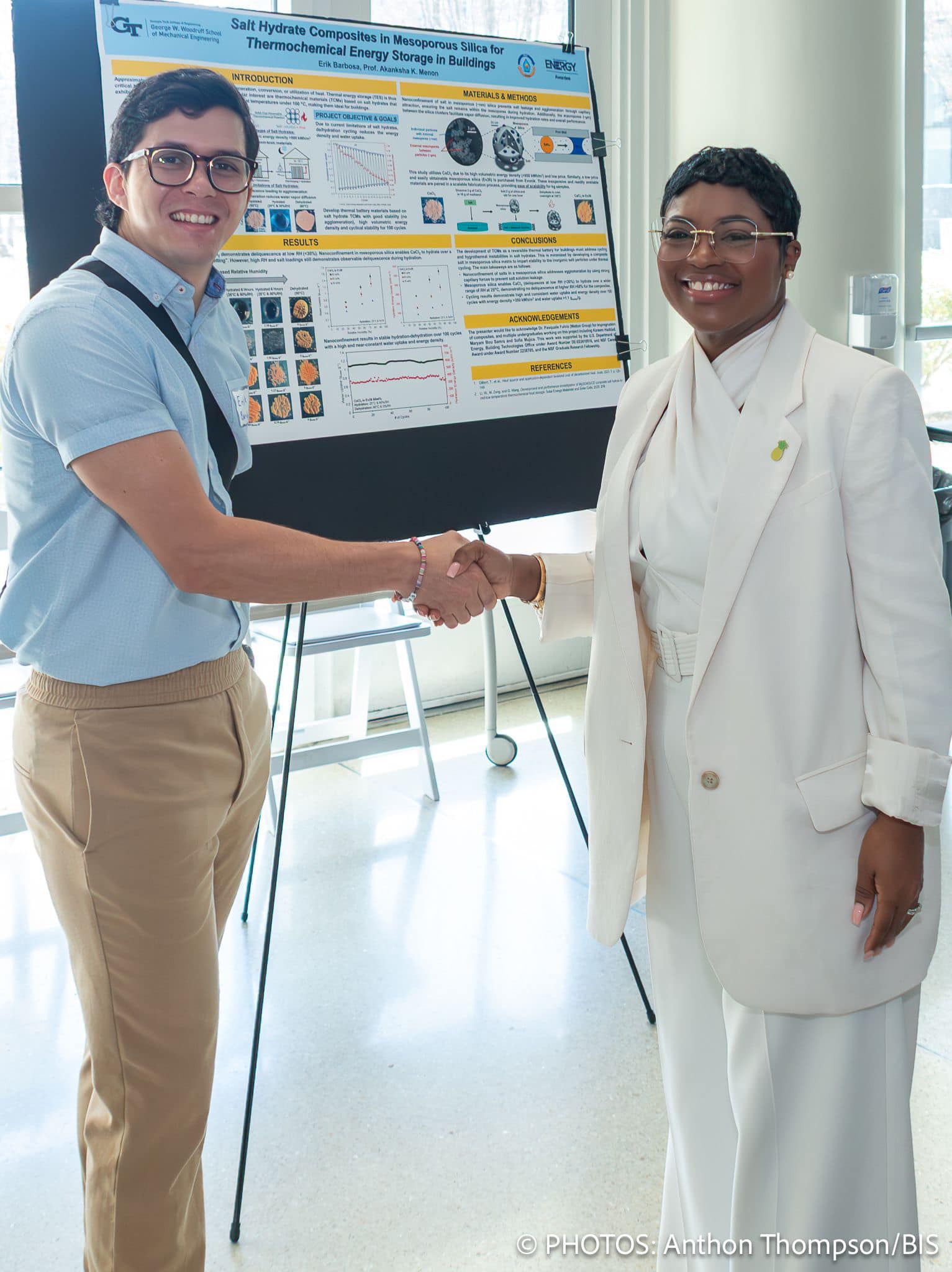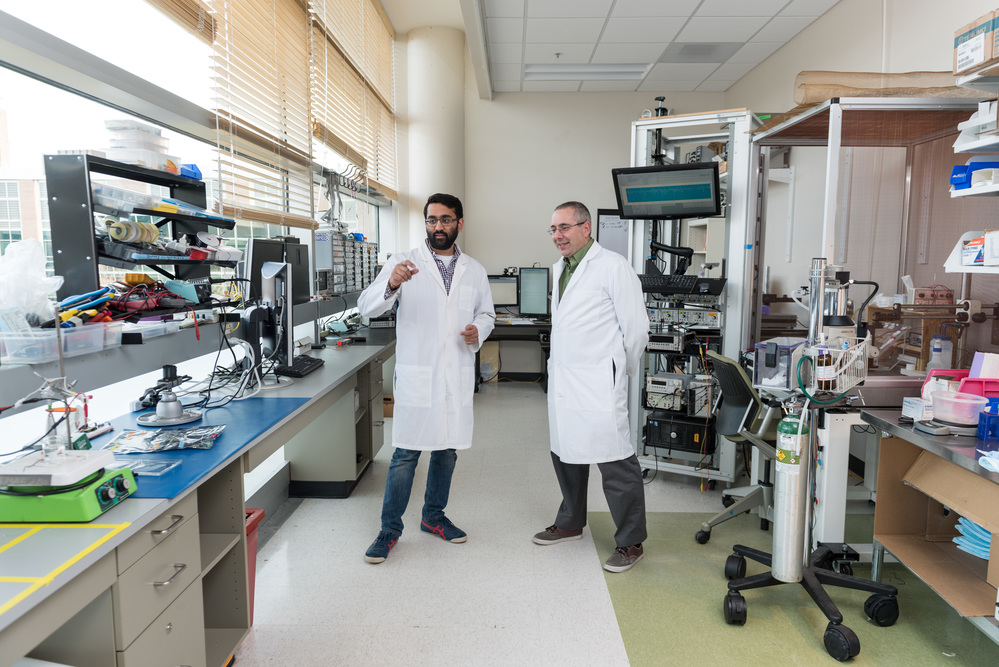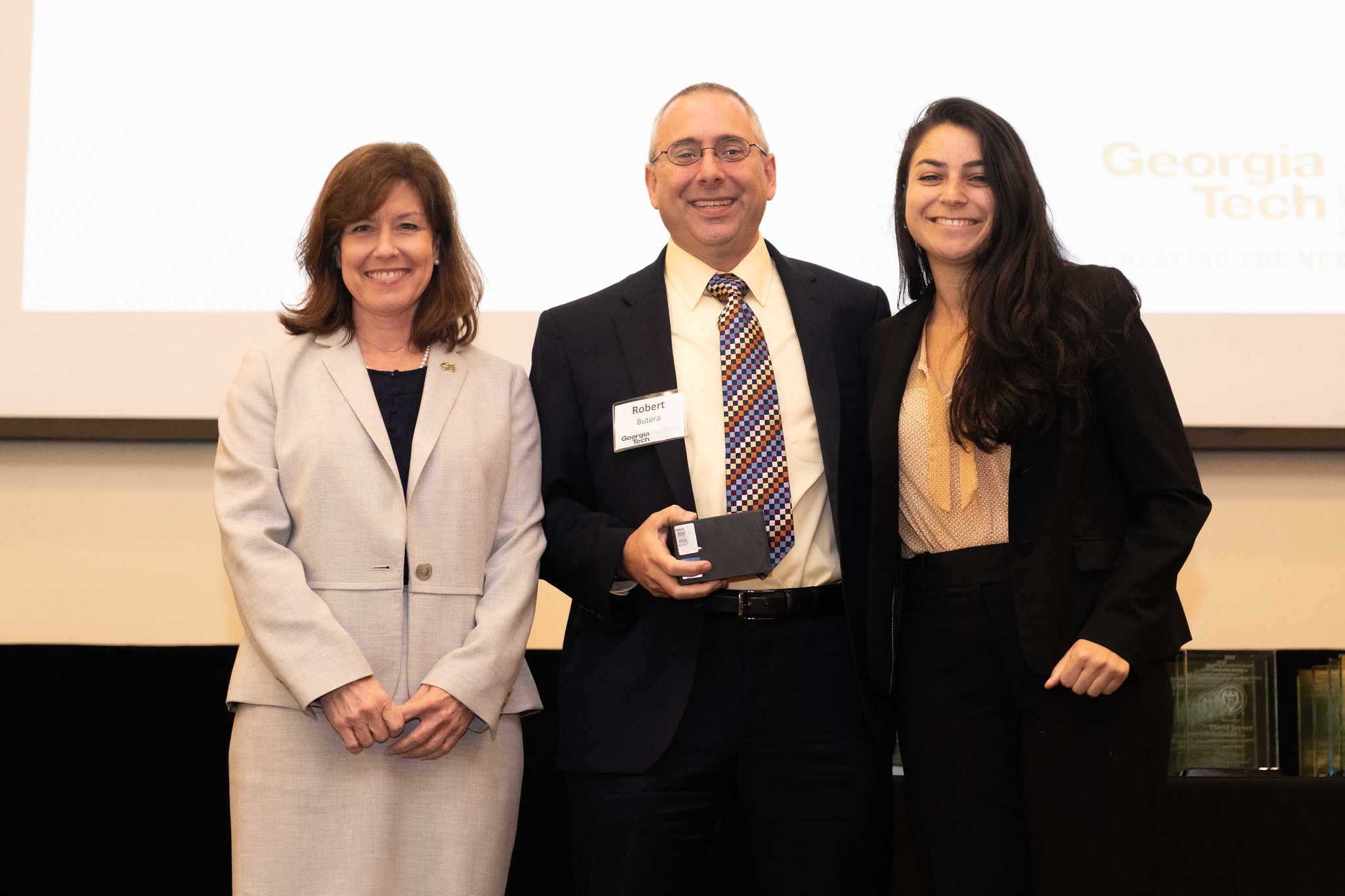The 2025 Southeastern Energy Conference: A Transformative Experience at Georgia Tech
Mar 18, 2025 — Atlanta, GA

Energy Club's 11th Southeastern Energy Conference Panel on The Potential of Renewable Hydrogen featured Eli Acree, Chemical & Biomolecular Engineering Undergraduate, Georgia Tech (Moderator), Panelists Scott McWhorter, Federal Opportunities and Strategy, Georgia Tech Strategic Energy Institute, and Board Chairman, Southeast Hydrogen Energy Alliance, Comas Haynes, Hydrogen Initiative Lead, Georgia Tech Strategic Energy Institute, Hayley Ryan, Field Engineering Manager, ExxonMobil, Luis Alcoser, GM Future Energy, Chevron Technology Ventures
The 2025 Southeastern Energy Conference, Georgia Tech’s annual student-led energy and sustainability conference, took place from Feb. 28 to March 1, 2025. Organized by the Energy Club at Georgia Tech, the conference welcomed over 100 attendees, including industry leaders, policymakers, researchers, and students, fostering dynamic discussions on the future of energy. The theme for this year’s conference, "Going Global: Energy’s Place on the World Stage," highlighted the international nature of energy challenges and solutions, emphasizing collaboration across borders.
The event kicked off with a keynote address from Hon. John Tien, who provided thought-provoking insights into the evolving energy landscape. Following the keynote, the first panel of the day, "The Ukraine Energy War: Lessons in Energy Security," featured expert analysis from Anna Mikulsa of the IDA Science and Technology Policy Institute and Gabriel Collins of Rice University’s Baker Institute. The session was moderated by Georgia Tech student Grant Espy. This was followed by a discussion on the role of nuclear energy globally, where Seth Grae, president and CEO of Lightbridge Corporation, and CJ Fong, vice president of Regulatory Affairs at Blue Energy, shared their perspectives, moderated by Anna Schafer, a student at Georgia Tech.
Throughout the day, attendees had the opportunity to engage with representatives from 10 local and regional energy companies through the Industry Showcase. Companies such as GE Vernova, Georgia Power, Kimley-Horn, and the Georgia Cleantech Innovation Hub were present, providing valuable networking and career development opportunities for students and professionals alike. The day concluded with an engaging panel on "The Potential of Clean Hydrogen," featuring insights from industry leaders including Comas Haynes of Georgia Tech's Strategic Energy Institute, Hayley Ryan of ExxonMobil, Luis Alcoser of Chevron Technology Ventures, and Scott McWhorter of the Southeast Hydrogen Energy Alliance, moderated by Eli Acree, a student at Georgia Tech.
The second day of the conference opened with a keynote speech from Tim Lieuwen, executive vice president for Research at Georgia Tech, who laid out what a carbon-neutral future could truly look like in energy. The "Cybersecurity for Energy Systems" panel brought together Seymour E. Goodman of Georgia Tech, Jake Braun of the University of Chicago, Juan Villarreal of Villarreal Energy, and Forrest Shriver of Sentinel Devices to discuss the challenges and solutions in securing energy infrastructure. Following that, the "Applications of Solar Microgrids" panel moderated by John Blankenhorn, a Ph.D. candidate at Georgia Tech, featured expert perspectives from Letian Dou of Purdue University, Ben Ollis of Oak Ridge National Laboratory, and Raymond Hill of Emory University’s Goizueta Business School.
One of the standout moments of the conference was the Student Symposium, where seven student researchers had the opportunity to present their work, competing for $500 in prize money. Projects explored topics ranging from photocatalysts to heat-driven desalination to thermal batteries for buildings.
The final panel of the event, "Scaled Sustainable Development," moderated by Conference Chair Sam Woolsey, a student at Georgia Tech, featured Jonathan Elkind of Columbia University’s Center on Global Energy Policy, Miguel Granier of the Cox Cleantech Accelerator, and Hon. Jobeth Lillian Coleby-Davis, Minister of Energy & Transport for the Government of the Bahamas.
Faculty Advisor Dan Molzahn also praised the conference, stating, "I've been incredibly impressed by the student organizers in pulling together such a remarkable and well-executed event. Given all the change occurring in the world today around energy, the students' foresight to focus on this topic by bringing in a broad range of experts was a huge benefit to the Georgia Tech community."
Reflecting on the success of the event, Sam Woolsey shared, "I was honored to serve as Energy Club's 2025 Conference Chair and to see the conference so positively received. It was a pleasure to see the ways this year's conference encouraged Georgia Tech engineers to get out of their comfort zone and discuss the policy and international affairs of energy."
The 11th annual Southeastern Energy Conference set a high standard for future student-led initiatives in energy and sustainability at Georgia Tech, fostering meaningful discussions and connections that will continue shaping the field. With a diverse lineup of experts, engaging panels, and invaluable networking opportunities, this event demonstrated Georgia Tech’s leadership in fostering innovative discussions on global energy challenges. The Energy Club extends its heartfelt thanks to all speakers, panelists, industry representatives, and attendees for making this conference a success. Stay tuned for future events and continued conversations on the evolving energy landscape!
Written by: 2025 Southeastern Energy Conference Committee Members: Braden Queen, Eli Acree, Sam Woolsey, Anna Schafer, Grant Espy, John Blankenhorn

Industry Showcase at the 2025 Southeastern Energy Conference, organized by the student-led Energy Club at Georgia Tech

Georgia Tech Student with Hon. Jobeth Lillian Coleby-Davis, Minister of Energy and Transport, Government of The Bahamas during the Student Poster Competition at the 2025 Southeastern Energy Conference.
Priya Devarajan || SEI Communications Program Manager
Written by: 2025 Southeastern Energy Conference Committee Members: Braden Queen, Eli Acree, Sam Woolsey, Anna Schafer, Grant Espy, John Blankenhorn
Devesh Ranjan Named Engineering Dean at University of Wisconsin-Madison
Feb 18, 2025 — Atlanta, GA

Devesh Ranjan
Devesh Ranjan, the Eugene C. Gwaltney, Jr. School Chair of the George W. Woodruff School of Mechanical Engineering, has been named dean of the College of Engineering at the University of Wisconsin-Madison (UW).
Ranjan graduated from UW and has been at Georgia Tech since 2014. He was selected as dean by UW Provost Charles Isbell, a Georgia Tech graduate and former dean of the College of Computing.
Ranjan will lead the Woodruff School through the spring semester. He will join UW in June.
“Devesh is a visionary leader who has created numerous programs to strengthen the Woodruff School community,” said Raheem Beyah, dean of the College of Engineering and Southern Company Chair. “Georgia Tech is my alma mater, and I know there’s nothing like going home. Devesh’s deep commitment and determination will undoubtedly lead to his continued success as he returns to UW to innovate and lead the university’s college of engineering. I’m grateful for his commitment to Tech and the Woodruff School, as well as his valuable guidance and partnership.”
Jason Maderer (maderer@gatech.edu)
Meet the Expert: Matthew Oliver
Mar 03, 2025 — Atlanta, GA

Matthew Oliver, Associate Professor, School of Economics, Georgia Tech, EPIcenter Faculty Affiliate
Students in Matthew Oliver’s economics of environment and international energy markets classes likely don’t have a clue about his unusual journey to the lectern: “I was bent on being a rock and roll musician from the time I was 16, and so I ended up dropping out of the University of Memphis after just three semesters,” says Oliver, an associate professor in the School of Economics at the Georgia Institute of Technology. “I was on tour for eight years — and I was starting to feel burned out.”
At a crossroads, Oliver decided to end his musical career — a choice he credits with launching him into academia. “I was 28 and wondering what to do with my life, so I reenrolled in college and discovered economics.” With a longtime love of the environment and growing concern for the climate, says Oliver, “I grew fascinated with solar power and other renewables and the new markets emerging around them.”
Today, his work in energy and environmental economics has implications for policies shaping the energy transition, from subsidies for rooftop solar to the expansion of battery storage.
“The current frontier of energy economics is electricity and renewables, and these are areas I am passionate about,” he says.
PVs and amped up electric use
One of Oliver’s core research thrusts is the solar rebound effect (SRE). This phenomenon involves a quirk of human behavior: When people install solar photovoltaic (PV) panels on the roofs of their homes, they often consume more electricity. “The introduction of solar energy does not perfectly displace grid-supplied energy, but instead reduces demand for grid-supplied energy on a less than one-for-one basis, because the household increases its total electricity consumption,” says Oliver. The bottom line: Solar PV systems may not lead to as much carbon emission reduction as anticipated.
Written by: Leda Zimmerman
Contact: Priya Devarajan, SEI Communications Program Manager
Point-of-Care Test Cracks Code for Cell-Free Protein Detection
Mar 06, 2025 — Atlanta, GA

The team's modular cell-free protein biosensor platform produces a simple color output based on the amount of protein detected in a sample. That makes it easy for any user, without specialized training, to read the results of a test at home or in areas with limited access to medical resources. (Photo: Candler Hobbs)
Chemical and biomolecular engineers at Georgia Tech have developed a plug-and-play platform for detecting protein biomarkers of disease that’s simple, flexible, and easy to use without costly lab equipment.
Their work could unlock a new wave of at-home testing options and provide new diagnostic capabilities in parts of the world where medical resources are scarce.
The testing platform fills a gap in using cell-free synthetic biology for disease detection. Existing cell-free tools have proven effective at measuring DNA, RNA, and other small molecules, but not proteins. That’s an important advance because proteins in viruses or bacteria tend to change less than the DNA or RNA sequences that encode those proteins. They’re also easier to detect since they can be found on the outside of cell walls or free-floating in biofluids.
“Diagnosing disease and democratizing medical care by putting it into the public's hands has great potential. You can have a big impact on a lot of people,” said Mark Styczynski, William R. McLain Endowed Professor in the School of Chemical and Biomolecular Engineering.
“I think about that a lot in terms of the developing world, but also there's a lot of healthcare inequality even in the United States. Studies have shown your ZIP code can determine your life expectancy. You can think about people in sub-Saharan Africa or people in rural Appalachia all benefiting. They’re among those who need more access to low-cost tools.”
Styczynski and a group of researchers led by former Ph.D. student Megan McSweeney presented their test in late February in the journal Science Advances.
Joshua Stewart
College of Engineering
Adam Steinberg Appointed as New Secretary of the Faculty
Mar 06, 2025 — Atlanta, GA

Adam Steinberg, the Pratt & Whitney Chair in the Daniel Guggenheim School of Aerospace Engineering, has been appointed as the new secretary of the faculty for Georgia Tech, effective February 26, 2025.
In his new role, Steinberg will serve as the permanent secretary for all faculty governance bodies, facilitating communication and governance across the Institute. The secretary of the faculty is appointed through a multi-phase process in which the faculty vote to recommend the new secretary to the president, who then affirms the appointment.
"Professor Steinberg's years of contributions as a chair, faculty member, and lab director make him an excellent choice for the secretary of the faculty role,” said President Ángel Cabrera. “He is a highly respected member of our faculty community, and I have no doubt that he will make a significant contribution to strengthening faculty governance at Georgia Tech.”
The secretary of the faculty plays an essential role in faculty governance at Georgia Tech, serving as the secretary for the Faculty Executive Board, Academic Faculty, Research Faculty, Academic Faculty Senate, and Research Faculty Senate. This position involves maintaining records, conducting governance elections, serving on the Insitute Policy Committee, liaising between campus administration and the faculty, and ensuring effective campus engagement with faculty initiatives. To take on this role full-time, Steinberg will step down from his position as associate chair for graduate programs in the Daniel Guggenheim School of Aerospace Engineering.
Reflecting on his appointment, Steinberg said, "I am deeply honored to take on this role and look forward to collaborating with faculty and administration to further strengthen these relationships. It is an exciting opportunity to contribute to the Institute's value of shared governance and to support the outstanding work of my colleagues."
Steinberg brings a wealth of experience to this role. He is the director of the Ben T. Zinn Combustion Laboratory, one of the largest academic combustion research facilities globally. Before joining Georgia Tech, he was a faculty member at the University of Toronto Institute for Aerospace Studies and served as a research scientist at the German Aerospace Center.
His research focuses on addressing scientific and technical challenges in aerospace propulsion and energy conversion devices. Collaborating closely with government and industry, his group develops advanced laser-based measurement techniques to explore complex thermal, fluid, and chemical processes in these systems.
Steinberg holds a B.A.Sc. in Engineering Science from the University of Toronto, an M.S.E. in Aerospace Engineering from the University of Michigan, and a Ph.D. in Aerospace Engineering from the University of Michigan. He is a Fellow of the Combustion Institute, an Associate Fellow of the American Institute for Aeronautics and Astronautics, and he serves as an Associate Editor for Combustion and Flame.
Steinberg succeeds J. Rhett Mayor, who has served as Secretary of the Faculty since 2018. During his tenure, Mayor worked to amplify faculty voices across campus and served throughout the COVID-19 pandemic as a dedicated liaison between the administration and faculty. His years of service have left a lasting impact on the Georgia Tech community. Mayor assumed the role of interim associate dean for faculty and graduate student affairs in the College of Lifetime Learning on January 1, 2025.
“Adam’s exceptional leadership skills, deep commitment to faculty governance, and extensive experience make him an outstanding choice for this vital role,” said Dima Nazzal, chair of the Faculty Executive Board. “We are thrilled to welcome him as secretary of the faculty. At the same time, we are immensely grateful to Rhett for his remarkable service and unwavering dedication to the faculty during his tenure. His impact has been invaluable, and we wish him the very best in his new role.”
Writer: Brittany Aiello, Faculty Communications Program Manager, Executive Communications, Institute Communications
Office of the Provost
Celebrating the Remarkable Career of Robert Butera
Mar 05, 2025 — Atlanta, GA

Celebrating the Remarkable Career of Robert Butera
Bill Dracos Appointed Interim Chief Research Operations Officer as Rob Butera Announces His Retirement
It is with immense gratitude and admiration that we announce the retirement of Robert Butera, who has served Georgia Tech with the highest dedication and excellence. As the chief research operations officer (CROO), Butera has facilitated the Institute’s research activities, overseeing research integrity assurance, research administration, research operations/infrastructure, and research development. His leadership and vision have left an indelible mark on Georgia Tech's research enterprise.
Butera’s journey at Georgia Tech began long before his role as CROO. He received his undergraduate degree in electrical engineering from Georgia Tech in 1991. He joined the Institute’s faculty in 1999, after earning his Ph.D. from Rice University and spending several years as a postdoctoral researcher at the National Institutes of Health. Over the years, Butera has held numerous pivotal roles, including vice president for research development and operations, associate dean for research in the College of Engineering, and director of the Neural Engineering Center. Prior to joining Georgia Tech’s research leadership, Butera directed the interdisciplinary bioengineering graduate program, then co-founded the Grand Challenges Living Learning Community.
As a professor, Butera graduated 15 Ph.D. students and mentored over 100 undergraduates, for which he received Georgia Tech’s Senior Faculty Outstanding Undergraduate Research Mentor Award in 2016. He also mentored several postdocs and master’s students.
Butera’s accolades are numerous, including the prestigious Georgia Tech ANAK award and election as a Fellow to both the American Association for the Advancement of Science and the American Institute of Medical and Biological Engineering. He held significant leadership roles within the IEEE Engineering in Medicine and Biology Society. These honors reflect his impact on the field of biomedical engineering and his dedication to advancing scientific knowledge.
Beyond his professional achievements, Butera’s personal passions have also enriched the larger Georgia Tech community. His love for whitewater kayaking, which he discovered through Outdoor Recreation Georgia Tech (ORGT), led to a decade of volunteering as an instructor and trip leader. This commitment to adventure and leadership development has inspired many students and colleagues alike.
"Rob's unwavering commitment to excellence and his visionary leadership have been instrumental in advancing Georgia Tech's research mission. His contributions have not only elevated our institution but have also profoundly impacted the broader scientific community. We are deeply grateful for his service and wish him all the best in his well-deserved retirement,” said Tim Lieuwen, executive vice president for Research.
Andrés J. García, executive director of the Parker H. Petit Institute for Bioengineering and Bioscience, shared these heartfelt words: "Rob, the ultimate Yellow Jacket, has been a tireless champion to improve research, educational, and operational processes at Georgia Tech. He has had tremendous positive impact in Georgia Tech, the state, and the nation. We will miss his deep knowledge and expertise, exceptional problem solving, practical perspective, and genuine care for faculty, staff, and students, and we wish him continued success in his next chapter."
Lena Ting, McCamish Foundation Distinguished Chair in Biomedical Engineering in the Walter H. Coulter Department of Biomedical Engineering, said, “Rob’s heart has a huge ‘GT’ stamped on it: He has always been engaged in all aspects of Georgia Tech life. I’m always amazed to hear about his undergrad teaching and mentoring, kayaking with ORGT, and advising his fraternity. At the same time, he worked tirelessly to enhance interdisciplinary research and solve challenges affecting faculty research, all while conducting his own innovative research. Rob is a GT nexus, always in the know about what is going on around campus and – more importantly – how and why it got to be that way. He is a great friend and colleague who is always available for a beer, and I’ll miss him dearly.”
As we bid farewell to Rob, we also extend a warm welcome to Bill Dracos, who will serve as the interim chief research operations officer, effective immediately. Bill brings a wealth of experience from his role as Deputy Chief Operating Officer at the Georgia Tech Research Institute and his previous leadership positions at George Mason University, Emory University, and PricewaterhouseCoopers. We are confident Bill will continue to build on Rob's legacy of excellence and innovation.
Thank you, Rob, for your years of service, your unwavering commitment to Georgia Tech, and your inspiring leadership. We wish you all the best in your retirement and look forward to seeing the new adventures you will undoubtedly embark upon.
Georgia Tech is conducting a national search for the next Chief Research Operations Officer. Learn more about the open position.



ChBE’s Krista Walton to Lead North Carolina State’s $517 Million Research Enterprise
Mar 04, 2025 — Atlanta, GA
Photo by Allison Carter
Georgia Tech chemical engineer Krista Walton has been named vice chancellor for research and innovation at North Carolina State. The role puts her in charge of NC State’s $517 million research enterprise.
Walton has served as Georgia Tech’s associate vice president for research operations and infrastructure since 2023. The role oversees research space and core facilities. She also manages research computing and data, while contributing to policies related to research administration and operations.
Walton is a professor and the Robert "Bud" Moeller Faculty Fellow in the School of Chemical and Biomolecular Engineering, where she’s served on the faculty since 2009.
“Georgia Tech has helped make me the scholar, researcher, and leader that I am today,” said Walton, who previously served as the College of Engineering’s associate dean for research and innovation. “As I prepare to take on this exciting new role at NC State, I will always be grateful for the mentorship and opportunities for growth that I received during my 16 wonderful years here.”
Walton’s research focuses on the design, synthesis, and characterization of functional porous materials for use in adsorption applications, including carbon dioxide capture and atmospheric water harvesting. She has co-founded three spin-off companies from her research over the past decade and currently serves as an associate editor for AIChE Journal.
Walton was the founding director and lead principal investigator (PI) on Georgia Tech’s first Department of Energy (DOE) Energy Frontier Research Center in 2014. That center, named UNCAGE-ME, advances the understanding of how porous and electrochemical materials used for hydrogen production and carbon dioxide capture and conversion evolve and degrade when exposed to emerging contaminants. DOE has renewed the center twice for a total of $25 million.
Walton begins her new role at NC State on June 30.
Jason Maderer
maderer@gatech.edu
Using Hemp in Building Insulation Could Make Structures Greener and Create Jobs
Feb 27, 2025 — Atlanta, GA

From left, Kelly Farmer, Akanksha Menon, Joe Bozeman, and Arjun Ramshankar with a package of traditional fiberglass insulation and a rack holding samples of potential hemp-based insulation materials created by graduate student Elyssa Ferguson in Menon's lab. The team has published an analysis outlining a path toward a viable hemp-based building insulation market in the U.S. Hemp insulation can be used in place of traditional fiberglass batt insulation and reduce the carbon footprint of buildings, but hemp materials currently cost twice as much. (Photo: Candler Hobbs)
It’s a fairly niche product now, but a new study from Georgia Tech engineers suggests insulation made from hemp fibers could be a viable industry in the U.S., creating jobs, a manufacturing base, and greener homes and buildings at the same time.
Making the switch could slash the impact of one of the biggest sources of greenhouse gas emissions: Buildings account for roughly 1/5 of emissions globally. By some estimates, using hemp-based products would reduce the environmental impact of insulation by 90% or more.
The Georgia Tech researchers’ work, reported this month in the Journal of Cleaner Production, is one of the first studies to evaluate the potential for scaling up U.S. production and availability of hemp-based insulation products.
Read about their findings on the College of Engineering website.
Joshua Stewart
College of Engineering
